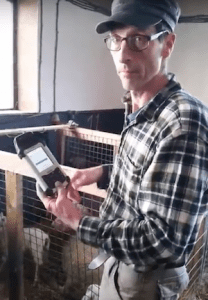 Dutch sheep farmer Diederik Sleurink gave Victorian saleyard managers a first-hand demonstration of how he tags and registers his sheep electronically on a Litams hand-held connected reader.
Dutch sheep farmer Diederik Sleurink gave Victorian saleyard managers a first-hand demonstration of how he tags and registers his sheep electronically on a Litams hand-held connected reader.
He also downloads the data to help select sheep or to identify a sheep in the field, and find out its age and lambing history.
He records the lamb’s birth date, sex, estimated birth weight, its dam’s identification and lambing history on the hand-held connected reader.
He must register a newborn lamb’s date of birth and identification number the central Dutch identification and registration (I&R) database within six months.
Good phone or wireless reception is sometimes a problem, but the hand-held connected reader saves data until this improves to enable downloading to the database.
Click on the video below to see Mr Sleurink explain to Sheep Central’s Terry Sim how he tags lambs and logs them into a national database:
Electronic tagging in EU since 2010
From 2010, all newborn animals in the EU have had to be identified electronically, although member states with populations of less than 600,000 sheep and goats or less than 160,000 goats can make electronic tagging voluntary for animals not entering intra-community trade.
The individual identity of each animal needs to be recorded in an on-farm holding register and when animals are moved, it should be recorded on a movement document accompanying the animal.
From 2012, individual recording has been mandatory for all sheep and goat movements, although animals born before 2010 can be sent to slaughter without individual recording.



Good evening from the Netherlands Mr Nix. It’s my dad you see in the article above. Let me answer your questions. First, we currently have around 1100 sheep. In summer, they’re divided into herds, grazing on nature reserves. In winter, a part of the sheep will lamb. Only these sheep come into the stables, the rest of them stay outside. I’m not really sure what you meant with ‘their names’, but our sheep are crosses of some local moorland sheep breeds and the British Suffolk type.
About mismothering: that’s very breed specific; for instance, by Merinos. We almost do not experience it in our sheep, let alone that it would be strengthened by clicking in tags. A problem we do experience is the management-side of this: we’re allowed by the government to have seven errors in our whole database. That’s the same for hobby farmers with two sheep and for companies like ours with 1000-plus sheep. We try, but it’s almost impossible to reach this level. That’s the frustrating part of all of this.
Thanks for your response to the earlier questions, Jelle. Sheep Central’s readers were very interested in our report on your business, as evidenced by the story’s high-ranking in our ‘Most Popular’ list, accessible on the lower left of our home page. Editor.
Lambing pens and indoor sheep. What are their names then? If we get huge subsidies to waste, you might do this. Imagine the mismothering in the real world of farms bigger than this whole country?